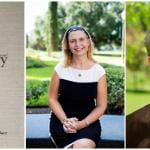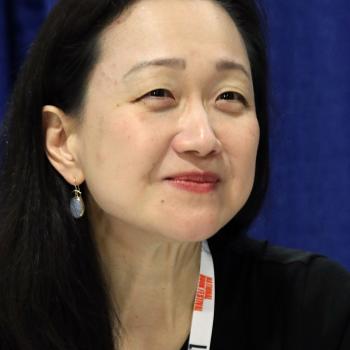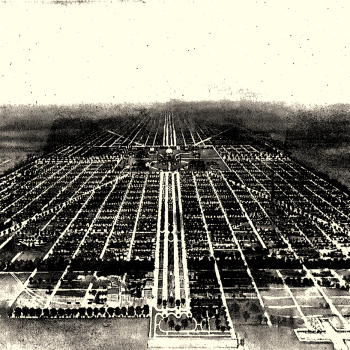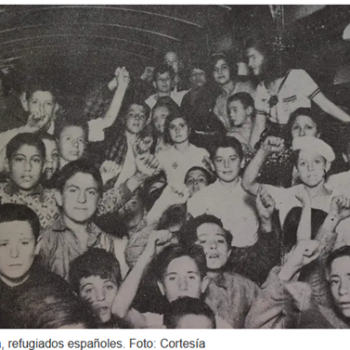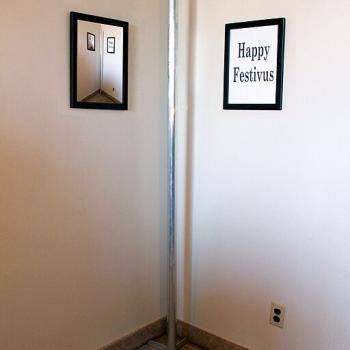Among the many fascinating cultural phenomena of the Covid-19 pandemic, the most intriguing to me has been the burst of ritual creativity borne by the requirements of social distancing. In April, for example, I participated in a virtual toast in celebration of a newborn’s bris; in June, I witnessed a wedding streamed via Facebook Live. Every Sunday, my parents watch Mass on YouTube, and I attend worship services through Zoom, where the gregarious types who like to whisper during church have license to do so through the chat function. Twenty-first century technology has provided helpful, if limited, tools for carrying on with religious rituals, but sometimes solutions have centered on old items newly repurposed for pandemic life. In Detroit, for example, Father Tim Pelc donned a face mask and shield and administered drive-through Holy Week blessings by using a squirt gun to shoot holy water at parishioners in their cars. Similarly, social media buzzed with photos of a Tennessee priest who used a squirt gun for baptizing a baby. (The priest later clarified that the photo was meant “for humor impact” and that the gun, which did not actually contain holy water, was aimed at the baby’s father, not the baby.)
Despite the creativity and occasional whimsy shown by religious people in the current crisis, certain rituals have faced continued obstacles, especially in situations of sickness and death. For example, Catholic priests ministering last rites to Covid-19 patients have been unable to touch people, give them communion, and anoint them with oil, and when these patients have passed away, their families have been unable to gather and grieve together through traditional funeral ceremonies. The pandemic has caused people of all religious traditions to experience exactly what they so often dread: being alone in their suffering, their dying, and their grieving. “The gathered community is essential to the grief process and the funeral process; it’s near as universal as we’ve got,” said William Hoy, a professor at Baylor University and an expert on social support in death, dying, and grief.
The cruel convergence of these distinctive aspects of the pandemic—the reality of sickness and death and the requirements of social distancing in an attempt to prevent that sickness and death—has produced a particularly painful problem. As friends and family die, people long to gather together and conduct the sacred rituals that allow them to show care, grieve, and commemorate the life of a beloved. And yet funerals, typically held in indoor spaces with many people in attendance, can be dangerous affairs, with some documented as lethal “superspreading” events. The pandemic, put simply, has put people in an impossible situation: as Covid-19 claims more lives, the more people wish to congregate for end-of-life rituals, which may, in turn, cause Covid-19 to claim more lives. No wonder, then, that those who mourn the death of loved ones are also, in part, mourning the loss of rituals that traditionally bring comfort and peace, and that funeral-goers who openly defy bans on public gathering have been the focus of such intense criticism and debate.
How, then, have religious people handled end-of-life rituals in the age of the coronavirus? Living through a global event of this scale of death and disruption has been a new experience for most people, but the truth is that this pandemic is not the first time that humans have experienced the peculiar pain of suffering, dying, and grieving from a distance. Migrants—and, in particular, refugees uprooted by war and other calamity—have often faced the dual affliction of death and forced family separation. The spiritual resilience and ritual ingenuity they have demonstrated in these moments offer a useful and hopeful lesson for those who grieve the loss of life and fear the loss of tradition in the chaos of our current crisis.
“A ‘long-distance’ cure”
Hmong refugees, who resettled in the United States beginning in 1976 in the aftermath of the “Secret War” in Laos, offer a particularly useful example to consider. The majority of Hmong refugees arrived in America adhering to a distinctive set of beliefs and practices that combine animism, ancestor worship, and shamanism. In the 1970s and 1980s, they found it difficult to conduct their traditional rituals in the United States, for several reasons. Part of the problem was that many Hmong rituals are complex affairs that require the involvement of the immediate and extended family, as well as elders and ritual experts equipped with specialized skills and knowledge.
However, American refugee policies deprived Hmong refugees of these essential ritual experts by separating refugees from their family, clan, and community. This family separation occurred in two main ways. First, American refugee policies prioritized the resettlement of refugees who had direct ties to the U.S. military. As a result, American refugee policies initially selected for refugees who were younger and less knowledgeable about traditional Hmong rituals, and left behind in the Thai refugee camps were the elders and ritual experts who had the most knowledge and skill about Hmong ceremonies. Second, resettlement planners deliberately dispersed Southeast Asian refugees across the United States in order to reduce the likelihood that refugees would form ethnic enclaves and overburden particular cities and states. This “scatter policy” forced refugees to live apart from their relatives and their community, and while Hmong refugees eventually did reconstitute their families, clans, and communities through secondary migration, this process sometimes took years to fully unfold.
The separation from family, the absence of ritual experts, and the relocation to new geographic settings: together, all of these forces created a crisis for Hmong refugees in their early years in the United States. Although resettling in a new country had held the promise of greater security and freedom, Hmong people in fact found themselves deeply unsettled by life in America, where they were forced to contend with even greater spiritual vulnerability as they struggled with the reality that it was difficult, and sometimes even impossible, to practice the rituals that had long sustained their spiritual and bodily wellbeing. They worried about the future of their souls, but also the fate of their Hmong ritual traditions and cultural identity.
The unsettlement of Hmong ritual life was felt most acutely during times of sickness and death. Hmong people worried, for example, about how they could cure an ailment and remain healthy if they had no shaman available to help them call a soul home during a hu plig ceremony or recapture a wayward soul during a ua neeb ritual. Even if Hmong people had access to a shaman in the United States, they were often constrained by other practical limitations. The particular demands of shamans’ work—for example, the need for a permanent house where a shaman’s spirits can reside—made practicing Hmong shamanism a challenge, especially in the context of the poverty and housing instability that so many refugees experienced in the initial years of resettlement. Nhia Yer Yang, a Hmong shaman in the Twin Cities, was “really happy” about all of the help he had received from Americans, but his lack of permanent housing was one reason why he struggled to continue traditional rituals. He pleaded for more help from the government and pointed out the spiritual consequences of his lack of permanent housing. “I hope the government would understand where this puts me as a shaman,” he said. “It makes it really hard. I don’t have a home…It is most difficult for me, I cannot adapt to this, the house is not my own. I cannot continue the traditional spiritual [traditions], to be ‘in touch.’ It is really hard, but hopefully in the future I can have my own home.” As he explained, the problem was not merely that he did not have a home to call his own, but that his shaman’s spirit needed to move with him every time he moved, and thus the lack of a permanent home created not only housing instability but also spiritual instability. “If I have to move and I’m in touch with the spirit and it lives in that home, I have to ask the spirit to leave,” he said. “Hopefully, one day I will have a steady place and won’t have to move around so much.”
Amid these challenges, Hmong refugees resettled in the United States nevertheless found creative ways to continue to practice the rituals of shamanism, often relying on technology and transpacific social networks to do so. In I Am a Shaman, the anthropologist Dwight Conquergood observed that Hmong refugees sheltering at Ban Vinai, a refugee camp in Thailand, were often actively involved in supporting the ritual lives of Hmong people resettled abroad. In this capacity, they played a vital role in sustaining Hmong traditions in an American context. He recalled how one family conducted a “long-distance” healing ritual by relying on a shaman who conducted a “proxy ceremony,” complete with a ritual pig, at Ban Vinai:
Xiong Houa’s neighbors, two partitions down from his room, had received money from relatives in the United States to buy a huge pig and perform a proxy ceremony for the grandfather now resettled in California. They explained the patient’s symptoms and failure to find satisfaction with Western health practitioners on the tape cassette that accompanied the money. Because it was more difficult to perform these rituals in the United States than in Ban Vinai, and also because they wanted the Ban Vinai relatives to share in the healing ceremony and feast, they were arranging this ‘long-distance’ cure. The shaman in Ban Vinai, Thailand, would perform for the patient in California.
Because this event occurred in the late 1970s or early 1980s, the family used the communication technology available to them: cassette tapes and the postal system.
Conquergood discovered that the Xiong family was not the only family whose rituals spanned the globe; other families’ rituals did so, too. “I first became aware of the practice when I attended healing rituals where no patient was visibly present,” he said. “In response to my question, ‘Where’s the patient?’ the officiants would reply, ‘In Iowa,’ or ‘Paris,’ or ‘St. Paul.’” As he explained, Hmong people conducted these rituals in this fashion because, on both sides of the Pacific, Hmong refugees faced challenges to their rituals, but also had different resources to offer:
The Hmong in the West have greater access to cash but more difficulty in carrying out these elaborate rituals. There is no lack of shamans and appropriate contexts in Ban Vinai, but money to purchase the sacrificial animals and accessories is hard to come by. The Hmong on both sides of the world benefit from this cooperative arrangement. The Hmong resettled in Western countries are able to maintain their traditions and meaningful connections with their relatives left behind. The resident Hmong in Ban Vinai profit from the protein supplement to their diet that comes from the sacrificed animals. Moreover, they are deeply satisfied knowing that they are performing an important spiritual service for the Hmong in the diaspora. They become, in effect, stewards of the sacred practices of their people.
In other words, even if Hmong people in the West have had had the money to conduct rituals, they were no longer had the shamans or the proper settings for shamans. They depended, in the end, on relatives in Asia to be the “stewards of the sacred practices of their people.”
“We just do the simple [rituals] and send everything back to the refugee camp”
Like sickness, death was another occasion when Hmong refugees acutely felt the ritual crisis produced by resettlement. For reasons similar to practicing shamanism—the separation from family, the absence of resources and ritual experts, the change in setting—conducting a traditional Hmong funeral was extremely challenging during the early years of resettlement. During the 1970s and 1980s, Hmong refugees lacked the necessary funeral spaces, material resources, ritual experts, and family and community members to conduct proper Hmong funerals without making any grave errors.
There is some variation in how different clans and sub-clans conduct traditional Hmong funeral rituals, but in general, the purpose of a Hmong funeral is to help the soul of the dead retrace the steps it had taken on earth, return to its homeland, reunite with the ancestors, and eventually be reincarnated. Like the arduous journey undertaken by the soul, traditional funerals are lengthy and demanding events that require a larger number of family members to conduct rituals day and night over the course of three days. During this time, relatives prepare and feast on ritually sacrificed animals and present the deceased with a variety of other items—a crossbow for hunting, a rooster for guidance, a sum of money—with the goal of making the journey and the afterlife as safe and as comfortable as possible. Throughout the funeral, musicians sing funeral chants and play “the death song” on the qeej, a polyphonic bamboo pipe. Hmong people traditionally conduct these elaborate funeral rituals with great care because they believe that if the funeral service is not be completed properly, the consequences are significant: the spirit of the deceased will never rejoin the ancestors and will never be reincarnated, but instead forced to wander or endure other forms of punishment. The spirit may also haunt and trouble living relatives, who face the possibility of spiritual or physical affliction that could possibly last for generations.
Conducting a traditional Hmong funeral completely and properly was very difficult during the early days of resettlement. To begin, Hmong people in the United States did not have the ritual experts or the extended family necessary for the elaborate ceremonies. Hmong funerals are large family and community gatherings, and for very practical reasons: conducting the complex, labor-intensive rituals required many people who are knowledgeable and experienced in Hmong funeral traditions. But with their family, clan, and community forced to live apart, Hmong refugees found that a traditional funeral was virtually impossible. Finding an appropriate space for the funeral presented another problem. American funeral homes, designed to accommodate funerals that lasted no more than a few hours, did not meet the needs of Hmong people, who needed a facility that they could use for seventy-two hours straight. On top of the limitation on hours, American funeral homes did not readily accommodate other traditions typically associated with a proper Hmong burial, such as the preparation and partaking of ritual feasts. Because funeral rituals involve many people who work together over a long period of time, meals are an important part of funerals, and Hmong people usually want to be able to eat at the funeral site, which is something that American funeral homes typically do not allow. Finally, burning paper money, which ensured that the soul of the deceased would enjoy wealth in the afterlife, at times caused concern among non-Hmong neighbors, who called the fire department when they saw smoke and fire.
For all of these reasons, Hmong refugees who resettled in the United States in the 1970s and 1980s faced a painful situation. Traditional Hmong funerals were nearly impossible to conduct properly in the United States. However, doing a traditional funeral was, for many Hmong people, one of the most important obligations to their family. What was at stake was not simply the maintenance of a sacred cultural tradition, but the fate of the soul of the deceased as well as the physical and spiritual wellbeing of the living. Soua, a Hmong funeral expert whom I interviewed in Minnesota, recalled how the inability to do traditional funerals worried Hmong people, who were deeply troubled by the spiritual harm that an improper or incomplete funeral might inflict on the family. “It scared every[one] here,” he said. He even felt the need to explain the circumstances to the souls of the deceased. “[W]e have to tell who passed away that this is not our country, this is not our home, this is not our town,” he said.
Determined to complete the funerals but burdened by the lack of material resources, space, and ritual expertise, Hmong people in the United States improvised and conducted funeral ceremonies as best as they were able. As with the rituals of shamanism, they sometimes used the postal system in order to draw on the expertise of relatives who remained in the refugee camps in Thailand. For example, after a Hmong family buried a relative in the United States, they gathered some of the dirt from the cemetery where the deceased person had been interred and sent the soil by mail to family members in Thailand. There, relatives finished the funeral and conducted the rituals that their Hmong American relatives had been unable to do. As Soua explained, “We just do the simple [rituals] and send everything back to the refugee camp.”
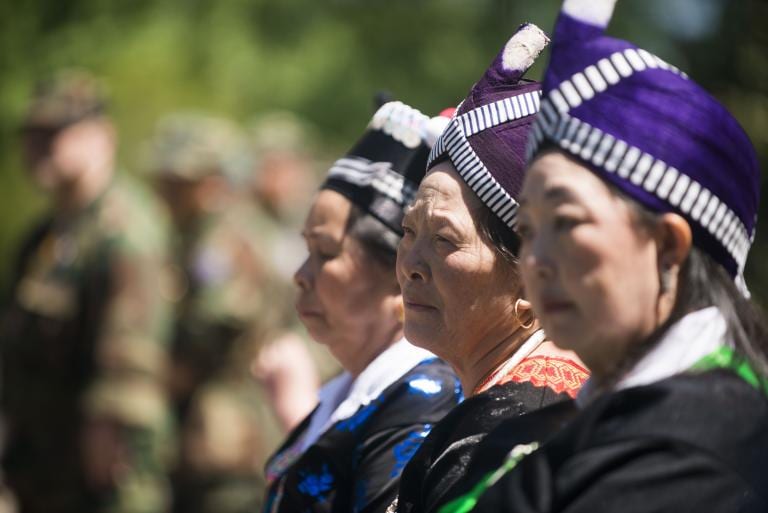
Paja Thao, a Hmong shaman who lived in Chicago in the late 1970s and early 1980s, offered this lament about his lack of knowledge of Hmong rituals and his uncertainty about continuing Hmong traditions:
But I can remember a little bit
The rhyme and way the words fit together
So I can remember some of the way
How to feed these spirits
Maybe if I try to do it
Maybe I can do it
But all the elders say
If you have never done before
You cannot do it in the right way
So it is with the Bull Spirit
And the Pig Spirit
Maybe I cannot do it
Because I am all alone
Paja Thao lamented the fact that he was “all alone,” a situation that posed a serious threat to Hmong ritual life. He would not be all alone forever, though. Indeed, in the four decades after the first Hmong refugees resettled in the United States, circumstances changed significantly. Hmong people reconstituted their communities by relocating to live closer to family and by sponsoring overseas relatives for resettlement. In ethnic enclaves forged through a combination of primary resettlement, secondary migration, and family sponsorship, Hmong Americans created vibrant communities where they established their own ethnic organizations, cultural education centers, funeral homes, and more to ensure that they have the resources to continue their traditional rituals. Distance, family and community separation, and lack of resources—the problems that once forced them to adjust their healing and funeral ceremonies in the 1970s and 1980s—today no longer pose as much a threat to their traditional ritual life. To be sure, the healing and funeral rituals conducted by Hmong Americans in 2020 are not carbon copies of those conducted by their grandparents, and many Hmong Americans, still finding traditional Hmong rituals difficult to practice in the United States, have adopted Christianity, which translates to kev cai tshiab, which literally means “the new way.” But the fear of Hmong refugees like Paja Thao—that Hmong ritual traditions might be forever lost—never fully came to bear.
What lessons do the Hmong offer for life during a pandemic, an experience that is no doubt different from war and forced migration, but which is also marked by death, despair, and distance? First, Hmong stories remind us that we can, and should, continue to honor the healing and end-of-life rituals that help us to grieve and bring us solace and hope. They remind us that the rituals to which we turn in this moment might need to change, out of necessity. And they remind us that we are spiritually resilient and ritually inventive, and it is precisely because our rituals are so important to us that we will find a way to adapt them, and they will endure. To be sure, there is a certain sorrow that might come with changing the ways that we care for the dying and mourn the loss of life. We might grieve that we can no longer grieve the same way we had before. Hmong refugees did that, too.
But perhaps the greatest lesson that we can draw from Hmong experiences is that in this moment, when we are anxious about the future and nostalgic for the comforts of the past, we can—and must—show compassion to ourselves as we simply do the best we can. We can, as Soua the Hmong funeral expert once did, admit that we are “scared.” Amid our worries, we can, as Paja Thao once did, still figure out how to do “some of the way.” And we might do these things because we can all be, in one way or another, the stewards of the sacred practices of our people.



